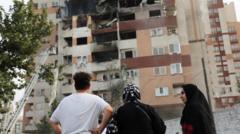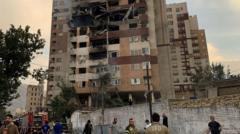The recent Israeli strikes against Iran, part of a longstanding intelligence initiative called "With the Strength of a Lion," relied heavily on detailed intel regarding Iranian military figures and nuclear facilities. Key operations have escalated in scope, targeting both leadership and strategic assets within Iran and its proxy Hezbollah.
Israel's Strategic Assault on Iran: A Pivotal Intelligence Triumph

Israel's Strategic Assault on Iran: A Pivotal Intelligence Triumph
The Israeli military executed a meticulously planned attack on Iranian nuclear sites, amplifying tensions in the region, rooted in years of covert intelligence operations.
Israel's latest strike on Iran, executed on Friday, represents the culmination of years of strategic intelligence gathering targeting critical nuclear facilities and key military personnel in the region. According to anonymous Israeli officials, whose insights were shared for transparency amid the sensitive nature of the operations, the extensive action was deeply embedded in intelligence frameworks established by Israel's military and the Mossad.
This clandestine operation, dubbed “With the Strength of a Lion,” relied on precise information regarding the activities and locations of prominent Iranian officials and scientists involved in the nation’s nuclear ambitions. Notably, the assault targeted both nuclear sites, such as Natanz, and Iran's air defense systems, raising questions regarding the scale of the operational impact.
In recent years, Israel has systematically targeted Iran and its affiliates as part of a broader strategy. High-profile reactions include the assassination of Iranian nuclear scientist Mohsen Fakhrizadeh, conducted using a remote-controlled weapon, and involvement in the 2020 drone strike on Qassim Suleimani, aimed at crippling Iran's intelligence framework.
In a notable escalation in 2024, Israeli intelligence operations penetrated Hezbollah, leading to a series of coordinated attacks that resulted in significant casualties and even the elimination of its leader, Hassan Nasrallah. The intricate nature of these operations involved advanced communication methodologies, including walkie-talkie coordination and expert use of advanced technology.
As Israel's military continues to assert its regional strategies through high-stakes operations, the implications for Iranian nuclear development and the broader geopolitical landscape remain precarious, as analysts assess the potential fallout from these aggressive maneuvers. The latest attack signifies a pivotal chapter in the ongoing conflict dynamics between Israel and Iran, underscoring the far-reaching consequences of intelligence-driven military action in contemporary warfare.



















